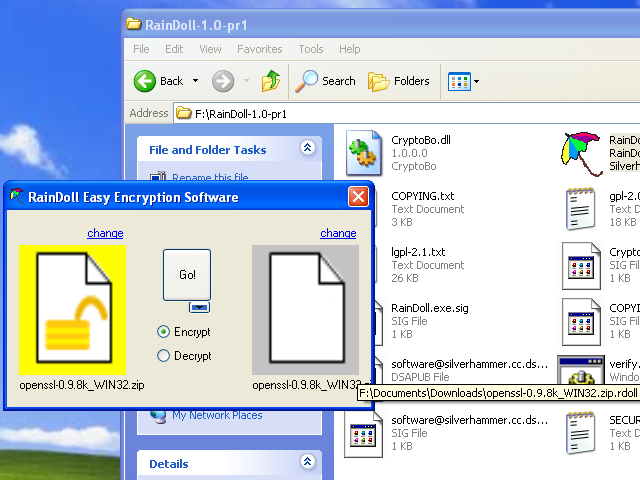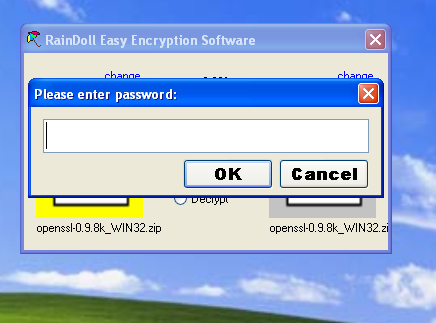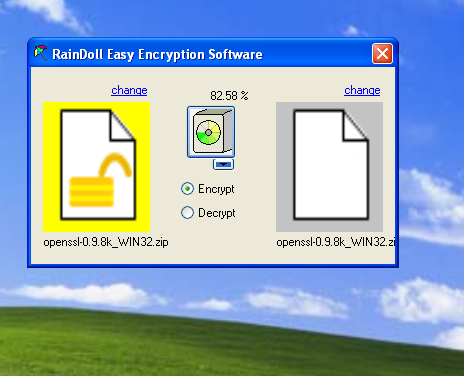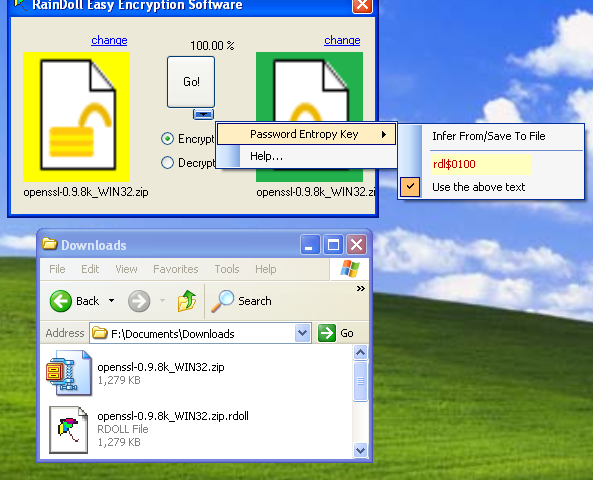RainDoll Easy Encryption Software
Software Description
What it is
RainDoll is software for encrypting and decrypting files with two primary goals - security and simplicity. To maximize security, it uses the symmetric encryption algorithm Rijndael (for which the program is named), with key sizes of 256 bits. The keys are generated based on a password - to perform this task the cryptographic algorithm PBKDF2, developed by RSA Laboratories for the purpose of generating keys from a password, and specified in IETF RFC 2898, is used. The use of a password instead of one of any other more complicated key management strategies is one of the main strategies used to provide simplicity. Also, the interface is designed to be smart - guessing values that the user will likely specify otherwise, and then providing a simple means to alter them. The interface is designed to be complete, yet unencumbered by the multitudes of features available from other encryption solutions.
What it is not
As eluded to by the above mention of simplicity as a primary goal, RainDoll is not a toolbox of file encryption possibilities. Therefore, it is not a one-software-to-perform-them-all approach to file encryption. RainDoll uses the Rijndael-256 algorithm. RainDoll does not provide a means to use public key cryptography to encrypt the files, nor does it provide any means to verify the authenticity of the file that has been encrypted. It encrypts and decrypts files based on a password, and a password salt.
Screenshots
the following screenshots are from the preview release 1 of version 1.0 of RainDoll

The main interface of RainDoll. (1) Choose a source file on the left. (2) Select an operation - Encrypt or Decrypt (RainDoll guesses which one you want based on the file extension). (3) RainDoll guesses the destination file, defaulting to a file with the same name, different extension, in the same directory as the source file. Click to change. Then click Go. Simple as 1-2-3-Go. Mostly 2 and 3 are automatic, so it's usually click-and-go.

Notice the simple and easy-to-read password dialog box. This password uses a supplied salt value (random salt to be implemented soon).

Notice the high-precision progress percentage, and custom graphic. Go button will double as a cancel button.

Successfully completed operations are indicated by 100.00% progress, and a flashy graphic. Failed operations show a giant red X.

A compact options menu allows the user to specify a salt to be applied to the passwords, or (yet to be implemented) the option of generating a random salt and saving it to the encrypted file (likewise, reading it back for decryption).
Public Key
for verifying the file distribution
-----BEGIN PUBLIC KEY-----
MIIDOzCCAi4GByqGSM44BAEwggIhAoIBAQDUDA5VJCM0jS6iK1dD2fhEo+xQtGzs
3mwgT8TThYtSqOeLtIbeRj0boaROGUvdfrHly9hGltFFNGik9NTz5FRZM0BptMHs
nhJwneTxrM/8PdzQ7AfkhwyKla9l2Bu+upXI8nHvXsFqTj1naz60RFVEhJjEdtGE
Cv4bfCEr3QByKrC3WUSnRP5Jn6q+ldu3+kwC7TNvWLs/bgqAhvaib07WzqQ5Jn7U
LDRYda0B4FiqWMq2RCdcxGJnjwSP0gNbBeBkzdntjnFQbWoG2hIZnDf62b+iM29e
UeasvO/WwfNzLD48uQwmP5qAu/2iCneyaVJtVpCXE7txHebhKJmHp3flAhUA6qUH
aT+miaKg7Sz01i60G3IFUOkCggEBAIjtKjh4T+hnpFo6l6+FtIGCoS+yzC5xEQq1
26UyZ4od19fbYQLzEqhAKvBFVJD8SFyVoGwKYvpp7julIHvJ6KdXsegHf4mytJXT
DYjNex0Uk1ypQK1z2RCcfqoIdV7H2wjtbf1otGKs4OOTyQ1WFexrZijc0/2bK/aM
udnYr/YkB0pfj4q5gcgG735s5t7a19HD04wBOUFr82e9ls/Rmxfuri5yYvvSxAzm
PMWYCSt9Gv10PSDSU3c0P9XtU5dTHAUvMSILCXlKH+/1HMn/lqxgqj5xQkhGGXad
LiR4YZ/vVy9sR+jAaNx+gebjc1r3TfukAf0Vbh1C4peldp6zYR8DggEFAAKCAQBA
659H5P3YK30VYS25N/pDNZ3JIDIfhHk1TMSPrqXmdYaKZWdP4IVSXGyN7s/iKq5r
kvU8jHwfx8azep283FmkIeeMMi1ay2Lf4bpHCB3d5HfUc5Fd1wZk1AP87QX4r598
0+wh2R8o1rK1jzE/A3MFI1a3zvT1u8YbBtwR7yISxDiiyi2E92T3/8XWnN6wQI9F
g3f2OW6iJt+fIe8tdNEMo3YzEgHKUE2FhU8lsk7gQ62jxXh4Cp98HdT041Xd8/Ih
hezBlKREVyrfxMaj0BJ+ZDa5ga0/t+dS9lxJKZBQXRDqvsgHvyIx1Do7r3DV4WDI
ZRxuX3zIVvhvsZWipvoo
-----END PUBLIC KEY-----
